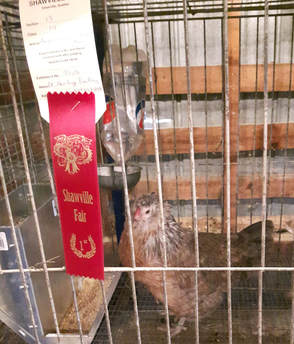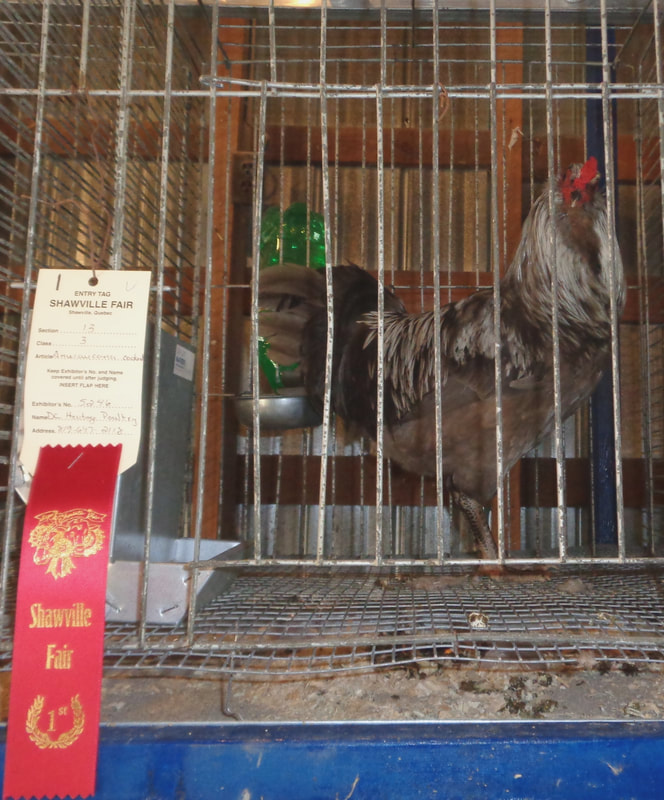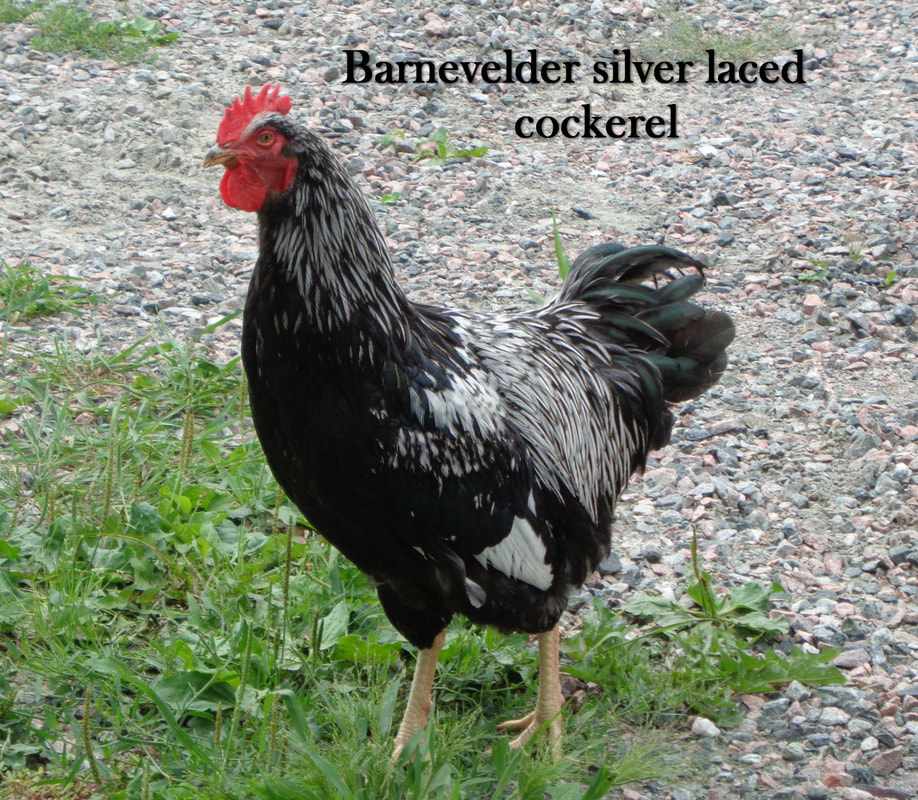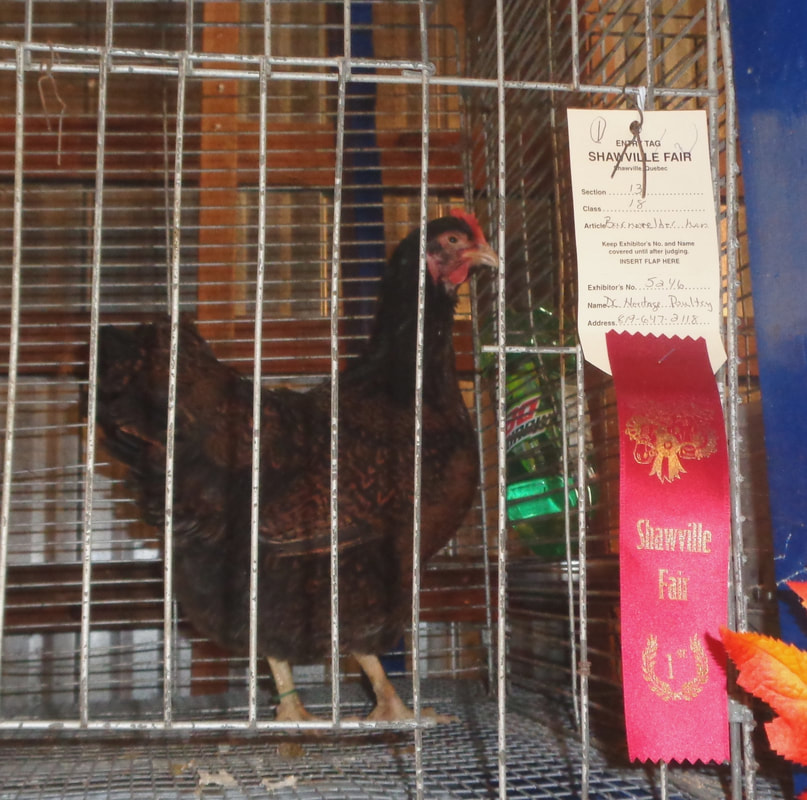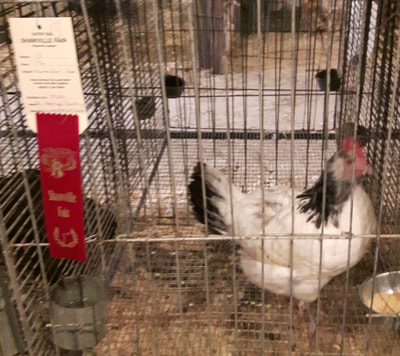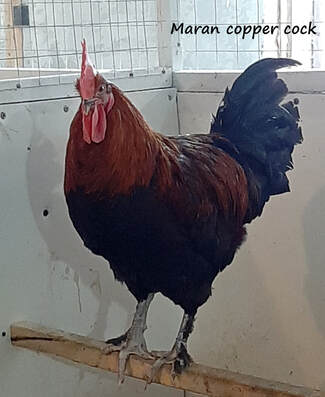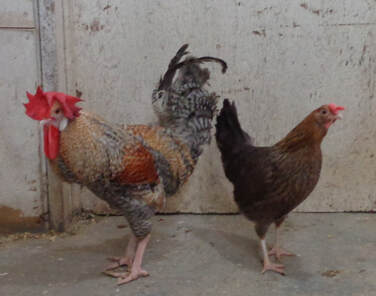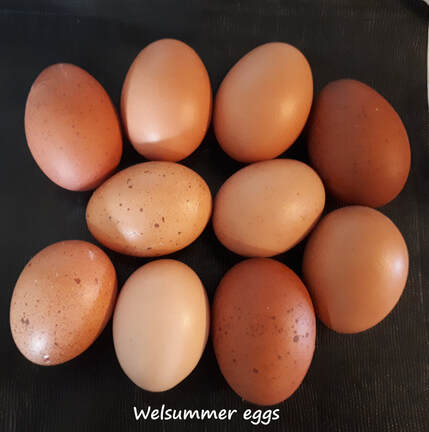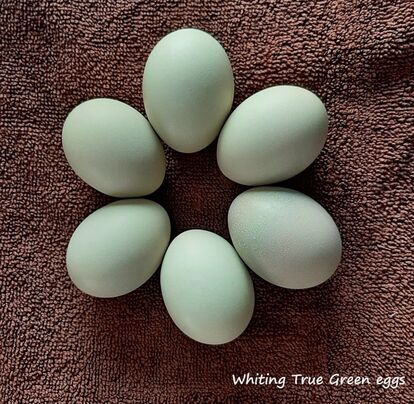Ancona

Description: Originated in the Le Marche region of Italy. It is named after the capital city of Marche, which is Ancona. the Ancona is a good layer of white eggs and can average about 220 eggs per year. Pullets may begin laying at 5months and hens don't tend to be broody. they are lively and hardy. Ity was imported to England in 1851 where it was greatly improved on. They are winter hardy. They do well in confinement or free range. They have a mottled color pattern of black with white spots.
Conservations status: watch list
Conservations status: watch list
Ameraucana and Easter eggers

Description: Developed in the United States in the 1970's. It derives form the Araucana chickens. Brought from Chile and was bred to retain the blue egg gene but to eliminate the lethal allele gene of the parent breed. They lay shades of blue, green eggs and even have blue or slate legs. Should not be confused with the Easter Egger a mix breed chicken that can lay a blue or green egg. They average approx 3 to 4 eggs per week and do not normally go broody. They are winter hardy and lays well into the winter. Bear confinement well and have a pea comb.
We have assorted colors running in one pen and blue wheaten/wheaten in other. Mottled & chocolate mottled project group, We also have Chocolate and black Easter Eggers.
We have assorted colors running in one pen and blue wheaten/wheaten in other. Mottled & chocolate mottled project group, We also have Chocolate and black Easter Eggers.
Andalusian

Description: Andalusians come from a region of Spain called Andalusia. They love to forage and their color and perky nature make them a good choice for a backyard flock. Beautiful blue feathers, Blue parents mated together produce chicks in 1 black, 2 blue, 1 splash ratio. Lay a large white egg. They are a ancient breed. They stand high productively. It is one of the best layers of eggs. an excellent winter layer. They tolerate confinement. This breeds rugged nature makes it hardy even in cold climates but combs may freeze on roosters. Hens lay early, starting at 5 months.
Conservation status: Watched
Conservation status: Watched
Araucana

Description: This breed of chicken originated in Chile and is know for its Blue eggs. this breed can be rumpless, tailed, tufted or bearded. They are medium to large birds. with a pea comb. They lay about 180-200 eggs per year and tend to go broody. They are placid, vigorous and hardy. chicks are strong, fast growers and mature early. Eggs are reported to be lower in cholesterol, but there is no specific proof of this. We carry clean faced, bearded, tufted and all the breeders are rumpless. Assorted colors
Australorp

Description: Developed in Australia in the 1920's form the black Orpington primarily for egg production rather then meat but very meaty body for a layer. They are excellent layers of medium brown eggs. They mature at approx 5 months and don't tend to go broody. they are calm and friendly birds. They are happy in small runs but love to be allowed to free range. They make good pets for children. They are usually black in color but there is a blue variety. We carry black & BLUE running together.
Barnevelder
|
Description:the Barnevelder is a medium heavy breed of chicken named after the Dutch town of Barneveld. The intention was to develop a hen that was both hardy and would produce eggs that were a copper brown color. Laying approx 150 eggs per year. They lay well into the winter months. they are a lazy chicken, so they don't need to be free ranged.Hens tend to go broody and are quite docile. Hardy birds that can be used for meat ad well. We have black laced and silver laced
|
Campine
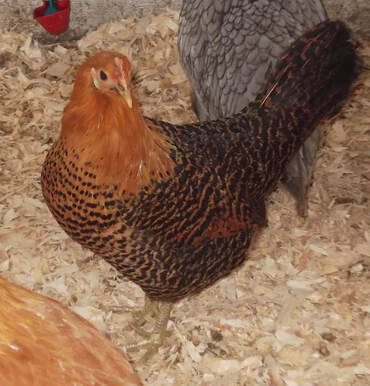
The Campine originated in the province of Antwerp in the Northern part of Belgium and south eastern Netherlands known there as Kempisch Hoen. The sexes are identical in color and the roosters are known to be hen feathered. They started out as a barnyard chicken but came to play a commercial role as the Flemish developed and perfected what was the forerunner of today’s commercial production system. The first part of the role was to produce fast feathering and growth when crossbred with Maline chicken for the production of meat. The second role was an auto-sexing breed for egg production. The Campines are fairly good egg layers of approx 156 white eggs per year and they do not go broody. They are vigorous foragers. They tolerate confinement and are winter hardy if weather does not get to severe. They come in two varieties Silver and Golden. The Silver has a pure white head and neck hackles, the rest of the bird is barred with beetle green on a pure white ground; the Golden has the same pattern, but the head and neck and body ground colour is gold instead of white. It is cool to note that if you breed Silver Campine hens to Golden Campine roosters the chicks can be sexed at day old, with hen chicks having a reddish blush and males having grey on the top of their heads. The breed weigh’s on average 6 lbs for roos and 4 lbs for hens. Campines are considered a hardy breed with an inquisitive nature and a little flighty. They are among the rarest of the domestic chicken breeds. We carry the Golden variety.
Conservation status: Critical
Conservation status: Critical
Catalana

The Catalana is an attractive dual purpose breed. They lay approx 208 eggs annually. Egg color is a white pinkish cream and they are not broody but lay well in the winter. The breed comes from Catalona in the eastern part of Spain near Barcelona. They should have white ear lobes, large single red combs and bluish slate shanks and toes. Males weigh approx 7-8 lbs and hens 6-7 lbs.They come in a variety of Buff coloring ranging from light to dark with a greenish black tail. Catalana’s are active, productive, easy to mange and very rare in North America. They are standard size with no Bantam version. They are noted to have succulent meat.
Chantecler

Chantecler’s are a dual-purpose breed developed for both meat and eggs. They are the only breed known to be created primarily by a member of a monastic order. They were developed in Canada in August 1907 by Brother Wilfred Chatelain, a Cistercian Trappist monk and Doctor of Agronomy. Brother Wilfred after touring the poultry flocks of the French speaking Oka Agricultural institute, an agricultural school at his Abby which is affiliated with the Universite de Montreal realized that no breeds of chickens had been established in Canada, and Canadian farmers and poultry fanciers could only have fowl of European and American developed breeds. He wanted to change this so working at the Abby of Notre-Dame du Lac in Oka, Quebec he first combines dark Cornish, white leghorns, Rhode island reds, white Plymouth rocks and white Wyandotte to create the white variant of the Chantecler, which was best for the commercial market. It was admitted in the APA in 1921. It is one of only 2 breeds of poultry that were developed in Canada. In the 1930’s the Partridge Chantecler was created by Dr. J.E. Wilkinson of Edmonton Alberta. He called His birds the “Albertan” crossing partridge Wyandottes, partridge cochins, dark Cornish and rose comb brown leghorns to produce a chicken more adapted to free range. It is important to note that the Partridge Chanteler and the White Chantecler are completely different breeds. Dr. Wilkinson submitted his Partridge Albertan birds for recognition to the APA, they did except them but then rather arbitrarily renamed them as Partridge Chantecler which was a disappointment to him. This variant was admitted to the Standard in 1935. There is also a Buff variety but have not been admitted to show standards. Chantecler rooters can weigh 9 lbs and hens 6.5-7.5 lbs, they have nice rounded breasts. They have yellow skin and beaks with very small red cushion combs and wattles. Hens are good winter layer producing approx. 200 light brown eggs per year and will go broody. They are extremely cold hardy, great for our northern climate. They are gentle calm birds. Thought to be extinct in 1979 they have made a comeback with 1000-1500 birds in Canada mostly in Quebec and Ontario. We carry White and Buff
Conservation Listed: Critical
Conservation Listed: Critical
Dominique

Description: Imported to America by Columbus on his second voyage of 1493. Then Dominque mayor the first chicken bred in america. They were extremely popular as a dual purpose bird. They have a rose comb and barred feather pattern. They are very hardy and are able to with stand very harsh weather. Hens go broody and are good moms. Dominiques are excellent foragers and are happiest being kept in coops. They are clam easy to handle. They come only in the barred color and are very hardy.They are a calm gentle breed. Lay a large brown egg. Hens will go broody.
Conservation status: critical
Conservation status: critical
Egyptian Fayoumi

Description: This breed was developed in Egypt has been around since the time of the pharaohs . They are not common, but the hens are excellent layers of small off white or pink - tinted eggs. Young hens are not given to broodiness. They are fast to mature. Pullets begin to lay at 4 1/2 months. They are feral- like and can be self-sufficient and forage for all own food. This breed has excellent resistance to a number of viral & bacterial infections. This makes them a very interesting breed.
Conservation status: study
Conservation status: study
Hamburg

Description: This is a breed that originated in Hamburg Germany and holland prior to 1700. Hamburg are a delightful breed. Known in England as the Dutch Everyday layer or sometimes simply Ever layers. They are prolific layers of small white eggs. They are excellent forager's & do well in backyard settings. they are a little shy but known to be a free spirited bird. They are a combination of beauty and utility. Pullets can start laying at 4-5 months old and continue laying for several years. They come in six colors. We carry the silver spangled.
Conservation status: watch
Conservation status: watch
Lakenvelder

Their name translated from Dutch means Shadow on a sheet. These Dutch birds were thought to be named after the town of Lakerveld Holland. They were developed around 1727 in the southern area of Holland & just across the border Nordrhein Westfalen area of Germany. Lakenvelders are as beautiful as they are useful, great egg layers of white nicely shaped eggs. They bear confinement well but are good foragers & very active. They are non broody. We carry Silver and Gold
Conservation status: threatened
Conservation status: threatened
Leghorn

The Origins of the Leghorn are not clear but it appears to derive from the light breeds in rural Tuscany, Italy. In Italy that are referred to as Livorno. In the USA they use to be called Italians but later changed to Leghorn, as Livorno translated to Leghorn in English. They were imported to North America during the middle 1800’s by Captain Gates. Most Leghorns have single combs but in some countries rose comb’s are permitted but not in Italy. The legs and skin are yellow, the earlobes white. The Federation francaise des volailles [ the French poultry federation divides the breed into four types: The American white, the English white, the old type [golden-salmon] and the modern type. For which 17 color variants are listed for large fowl birds and 14 for bantams. It also recognizes an auto-sexing variety the cream Legbar. They are great layers averaging 280-320 large to X-large eggs per year. They don’t go broody. Leghorns are good foragers and can get much of their diet this way. They are good flyer’s and can roost in trees if given the chance. The mature weight of a standard size rooster is 7.5 lbs and hens 6 lbs. Bantam size roosters 2.2 lbs and hens 2 lbs. They are in the Mediterranean class. They are intelligent. They are tolerant of the heat but may need a bit of care in the winter to prevent frostbite on the comb. Overall they are considered very hardy. They are considered a dual-purpose heritage breed but are mainly used as layers..
We carry the Mille Fleur color variety.
Maran

Description: This breed was developed in the port town of Marans, in the department of Charente-Maritime in the Port Au-charentes region of western France. Call Poule de Marans in France. It is a dual purpose fowl known for its extremely dark eggs and fine meat quality. Marans are generally quiet and docile and are also tough and disease resistant. They will lay around 150-200 eggs per year depending on the variety. The french Marans have feathered eggs and the English Marans don't. There are 9 recognized colors. We carry black copper, wheaten & blue wheaten and golden cuckoo.
Norwegian Jaerhon
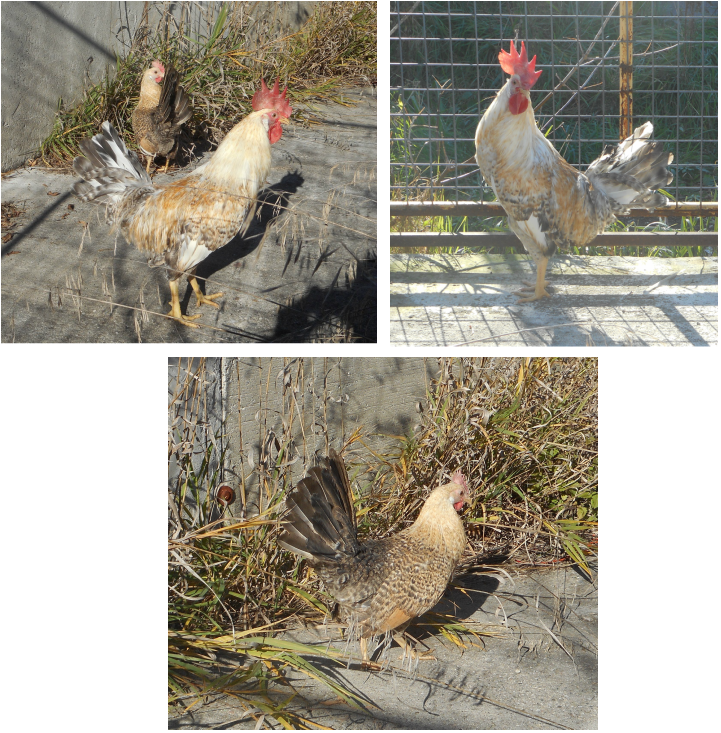
Norwegian Jaerhon is the only breed developed in Norway, in the Jaer district about 1920. It is a landrace breed. The word Jaerhon means yard bird or hen. Landrace refers to domesticated animals adapted to the natural and cultural environment in which they live, or originated. They often develop naturally with minimal assistance from humans using traditional breeding methods. The bird has a single comb, yellow legs and white ear lobes. They are now not typical setters as the broodiness in a large part has been bred out to get better egg production. They are an active bird and are known to be quite hardy and are good foragers. They have only been in North America since 1998. It is a small breed not much bigger than a banty with roo’s weighing 2 kgs and hens 1.75kgs but hens lay a large fowl white egg and its said they can wear themselves out laying lots of large eggs. This breed is auto-sexing and chicks are sexable at day old. Approved colors according to the Norwegian Standard of Perfection: is Light and Dark but sports are not uncommon, but are not accepted according to the SoP. We carry the Dark variety.
Penedesenca
|
The Penedesenca chicken breed originated in the Catalonia region of Spain around the city of Vilafranca del Penedes in the first half of the 20th century. It was developed from the native barnyard chickens that were known for producing very dark eggs. Hens produce a very dark chocolate egg similar to a Copper Marans egg color. Pullets just starting to produce eggs can lay a very dark chocolate egg very close to black but eggs tend to lighten as the season progresses. This Spanish breed is an exception to the rule that birds with white earlobes lay white eggs. Hens rarely go broody. They lay approx 150 medium sized eggs per year. They are good foragers and do well in free range. Pene’s as they are affectionately called have a unique appearance with red wattles, red earlobes with white centers and an uncommon red comb. Its comb is called a carnation comb or King’s comb. It is similar to a single comb but has several lobes at the rear. The combs stand upright in males and droops to the side in females. Birds need a bit of heat in winter so combs don’t freeze. The breed is very active and is also suitable for high quality meat production. Roosters weigh from 4.4 lbs to 6 lbs and hens weigh 3.75 lbs to 4.5 lbs. The breed is rare and was almost extinct by the 1980’s but now making a comeback. There are four colors: Crele, Wheaten, Partridge, and Black which is the largest.
We carry the Crele: { Barrada in Spanish } which tends to be somewhat autosexing, the female chick has a white spot on her head and the male chick has a large spot that extends to the back giving them a lighter coloration |
Plymouth Rock
|
The Plymouth Rock chicken is a excellent dual-purpose All-American breed of domestic chicken. It got its name from the town of Plymouth, Massachusetts around 1865. A cross between a Dominique rooster and a black Cochin hen or Black Java hen or both was the start of the breed. They are one of the most popular breeds on small farms today. Rocks are good year-round layers, even in the winter months of approx 280 light brown eggs. They are known to be long lived. They are a sweet chicken with a calm nature but will puff up when on her nest. They do well in confined areas but do love to go for a run. Plymouth Rocks are known to be good choice for incubating and hatching their chicks and make excellent mothers. They are a large chicken with roosters weighing 9.5 lbs and hens 7.5 lbs. They have a red single comb, red ear lobes with yellow skin and legs. They come in a variety of colors: Barred is most common, White and Buff are recognized colors and other colors: Columbian, Blue, Black, Partridge and rare : Silver Penciled.
We carry the Silver Penciled. NEW for 2021 will be Barred and Columbian |
Rhode Island Red

The Rhode Island Red, also known as R.I.R. is an American breed of chicken held in such high esteem that they’re the official Rhode Island state bird. It is a utility bird use for both meat and eggs. It is a popular choice for backyard flocks. Rhode Island’s are used in the creation of many modern hybrid breeds, mainly due to the great prolific laying abilities. They lay on average 5-7 eggs per week or 312 eggs in their first year and 223 in their 2nd year. They lay a large brown egg and are extremely winter hardy. They are also very good for meat with rooster weighing 8.7 lbs and hens 6.5 lbs. The bird is a rust color with darker shades of red bordering on maroon to black. Feet and legs yellow with a bit of reddish hue on the toes. The breed has a red single comb. They were once hugely popular in America but fell in decline along with the small farmer but they are making a comeback due to small flock owners. The Rhode Island Red was originally bred in Adamsville, in a village which is part of Little Compton, Rhode Island. The foundation sire of the breed was a Black Breasted Red Malay rooster imported from England This rooster is on display at the Smithsonian Institution as the father of the Rhode Island Red breed. In 1925, the Rhode Island Red club of America donated funds for an elegant monument to the Rhode Island Red in Adamsville. { The monument is now on the National Register of Historic Places.] A competing monument to the Rhode Island Red, claiming its creation not for the poultry fanciers, but for the farmers who grew them commercially in great numbers in Little Compton, was erected by the state in 1988, a mile or so south of Adamsville. Over the years the breed have gotten lighter in size and color but the greatest conservation interest is the “ Old-Type” Rhode Island Reds which are larger and darker red in color and more broody. These birds are becoming rare. Hens have a clam disposition but some rooster can become aggressive. We are trying to stay with the darker red, larger birds of the “Old Type” as possible.
They are on conservation list as : Watch
They are on conservation list as : Watch
Rhode Island White

The Rhode Island White originated in 1888 in State of Rhode island, USA by J.Alonzo Jocoy of Peacedale, Rhode island, USA. Rhode Island Whites are not related to the Rhode Island Reds and are a distinct breed. They are a calm easy going chicken and will make an enjoyable addition to the family farm. The breed is known to lay 240-250 large to extra large brown eggs per year and is also reputed to be a splendid meat fowl and excellent winter layer. Hens will go broody and are excellent mothers but some roosters can become aggressive and protective of hens and chicks. Rhode Island Whites are a completely white bird with males weighing 8.5 lbs and females 6.5 lbs. They are a yellow skinned dual purpose breed. They are rose combed and single combed with red earlobes and wattles. They are suitable for confinement or a free range system. They love to forage. They are suitable for all climates and are cold hardy. The Rhode Island White was recognized as a breed and accepted into the Standard of Perfection in 1922. There is also a Rose Comb clean legged Bantam Variety Classification as well. We carry the standard size single combed variety.
Conservation Status: Threatened
Conservation Status: Threatened
Welsummer - SOLD OUT

Description: Welsummer or Welsumer is a Dutch breed of chicken as is named after the small village of Welsum but they were originally developed in the area along the river Ysel to the north of Deventer, Holland about 1900-1913 and is a dual purpose breed. They lay approx 180 large dark terracotta reddish brown eggs per year. The hens will go broody but usually in late spring. They are quite productive for about 3 years. Roosters weight approx 6 lbs and hens 4.5-5 lbs. They are a friendly, easy handled, pleasant and intelligent bird. They do bear confinement well but are good foragers as well as being winter hardy. They are single comb and clean legged. A fun fact is that the rooster named Cornelius on the Kellogg’s corn flakes box is a Welsummer. Three plumage colors are recognized by Entente Europeenne D’Aviculture et de Cuniculture, the black-red partridge, gold duckwing and silver duckwing, but the only color recognized in its native Netherlands is red partridge. We carry the black-red partridge.
Whiting True Green
|
This breed was developed in California, USA by Dr. Thomas Whiting, a poultry geneticist specializing in developing feathers for fly-fishing industry. Hens will lay a huge number of medium to large light green to olive green eggs, but occasionally one will lay a brown egg. They have an astounding feed to egg ratio. They don’t go broody and they free range well. Whiting’s can handle most weather conditions, cold or heat. The breed is docile and easy to handle. Roosters weigh 7 lbs and hen 4 lbs. Their coloring is a light chestnut to light red with a red single comb, white earlobes and yellow legs but some roosters can be very light almost white in color. Chicks hatch in a variety of colors from white, golden to chestnut to a darker reddish brown.
|
